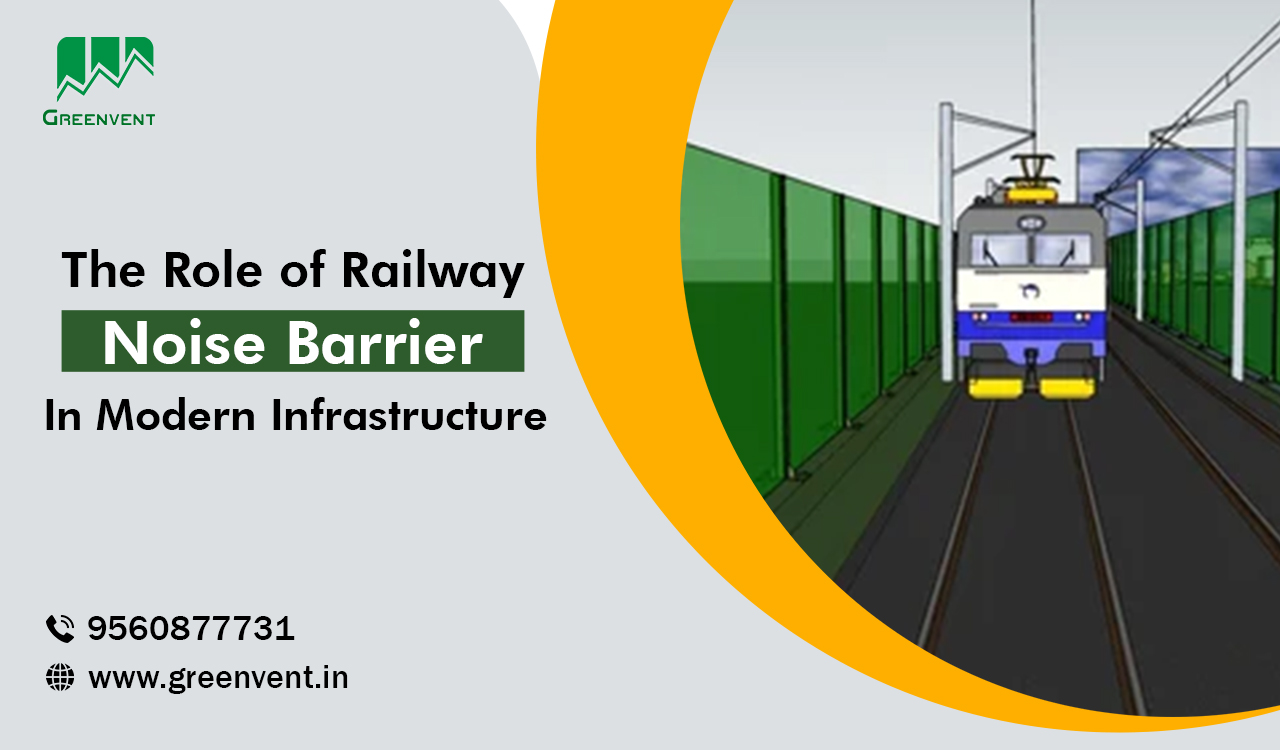Railways are essential to modern infrastructure, providing efficient and reliable transportation for passengers and freight. However, the noise generated by trains can be a significant source of disturbance for communities living near railway lines. To address this issue, railway noise barriers have become a critical solution. As a leading railway noise barrier manufacturer, Greenvent is at the forefront of developing and implementing these barriers to create a quieter and more comfortable environment for residents. In this blog, we will delve into the significance of railway noise barriers, discussing their design, construction, and the advantages they offer to communities and the environment.
Understanding Railway Noise Barrier
Sources of Railway Noise
Railway noise primarily originates from three sources: rolling noise, traction noise, and aerodynamic noise. Rolling noise is produced by the interaction between train wheels and the track.. Traction noise comes from the engines and other mechanical components, while aerodynamic noise arises from the movement of the train through the air at high speeds. All these sources contribute to the overall noise level, which can be disruptive to nearby residents.
Impact of Railway Noise on Communities
The impact of railway noise on communities can be significant. Extended exposure to elevated noise levels can result in numerous health problems, such as sleep disruptions, cardiovascular conditions, and stress-induced illnesses. Additionally, railway noise can reduce the quality of life by interfering with daily activities such as conversations, watching television, and enjoying outdoor spaces. As urban areas expand and encroach upon railway lines, the need for effective noise mitigation solutions becomes increasingly critical.
The Role of Railway Noise Barrier
Functionality of Noise Barriers
Railway noise barriers serve as physical obstacles that block or reduce the propagation of sound waves from the railway to the surrounding areas. These barriers are designed to absorb, reflect, or deflect noise, thereby lowering the overall noise levels experienced by nearby communities. The effectiveness of a noise barrier depends on various factors, including its height, length, material composition, and placement relative to the noise source.
Materials Used in Noise Barriers
The materials used in the construction of railway noise barriers play a crucial role in their performance. Common materials include concrete, steel, wood, and various types of acoustic panels. Every material possesses unique properties that make it ideal for particular applications. For instance, people value concrete barriers for their durability and high sound absorption capabilities, while they appreciate steel barriers for their strength and ease of installation. Acoustic panels, on the other hand, often enhance the sound-absorbing properties of barriers, providing additional noise reduction benefits.
Design and Construction of Railway Noise Barriers
Key Design Considerations
Designing an effective railway noise barrier requires careful consideration of several factors. These include the height and length of the barrier, the distance from the noise source, and the topography of the surrounding area. The height of the barrier is particularly important, as it needs to be tall enough to block the direct path of sound waves. The length of the barrier should be sufficient to cover the entire noise source, preventing sound from bypassing the barrier. Additionally, the barrier’s placement must consider the terrain and any existing structures that could affect its performance.
Construction Techniques
The construction of railway noise barriers involves several steps, starting with site preparation and foundation work. The foundation must be strong enough to support the weight of the barrier and withstand environmental conditions such as wind and rain. Once the foundation is in place, workers assemble and install the barrier components according to the design specifications. This may involve using cranes and other heavy machinery to lift and position the barrier elements. After installation, the barrier is tested to ensure it meets the required noise reduction standards.
Benefits of Railway Noise Barriers
Health and Well-being
One of the most significant benefits of railway noise barriers is the improvement in the health and well-being of residents living near railway lines. By reducing noise levels, these barriers help to minimize the risk of health problems associated with noise exposure, such as sleep disturbances and cardiovascular issues. This leads to a better quality of life for community members, allowing them to enjoy their homes and surroundings without the constant disruption of railway noise.
Environmental Impact
Railway noise barriers also have a positive impact on the environment. By mitigating noise pollution, they help to preserve the natural soundscape and protect wildlife that may be sensitive to noise. Additionally, the materials used in the construction of noise barriers can be selected to minimize environmental impact, such as using recycled or sustainable materials. This contributes to the overall sustainability of railway infrastructure projects.
Economic Benefits
Investing in railway noise barriers can also have economic benefits. Reduced noise levels can increase property values in areas near railway lines, as homes become more desirable places to live. Additionally, noise barriers can help to attract businesses and other developments to the area, boosting the local economy. The construction and maintenance of noise barriers also create job opportunities, further contributing to economic growth.
Pioneering Railway Noise Barrier Manufacturer: Greenvent
Our Commitment to Innovation and Quality
At Greenvent, we are dedicated to providing innovative and high-quality railway noise barriers that meet the needs of modern infrastructure projects. As a leading railway noise barrier manufacturer, we leverage advanced materials and cutting-edge technologies to design and construct barriers that offer superior noise reduction performance. Our commitment to quality ensures that our products are durable, reliable, and effective in creating quieter and more comfortable environments for communities.
Custom Solutions for Diverse Needs
We understand that each railway project is unique, with its own set of challenges and requirements. That’s why we offer custom solutions tailored to the specific needs of our clients. Whether we are developing noise barrier solutions for a high-speed rail line in a densely populated urban area or a freight corridor in a rural setting, our expertise and experience ensure optimal results. Our team of engineers and designers works closely with clients to understand their needs and provide solutions that are both practical and cost-effective.
Conclusion
Railway noise barriers are an essential component of modern railway infrastructure, providing significant benefits to communities, the environment, and the economy. As a leading railway noise barrier manufacturer, Greenvent is committed to delivering innovative and high-quality solutions that address the challenges of railway noise. By investing in effective noise mitigation measures, we can create quieter, healthier, and more livable communities for everyone.

